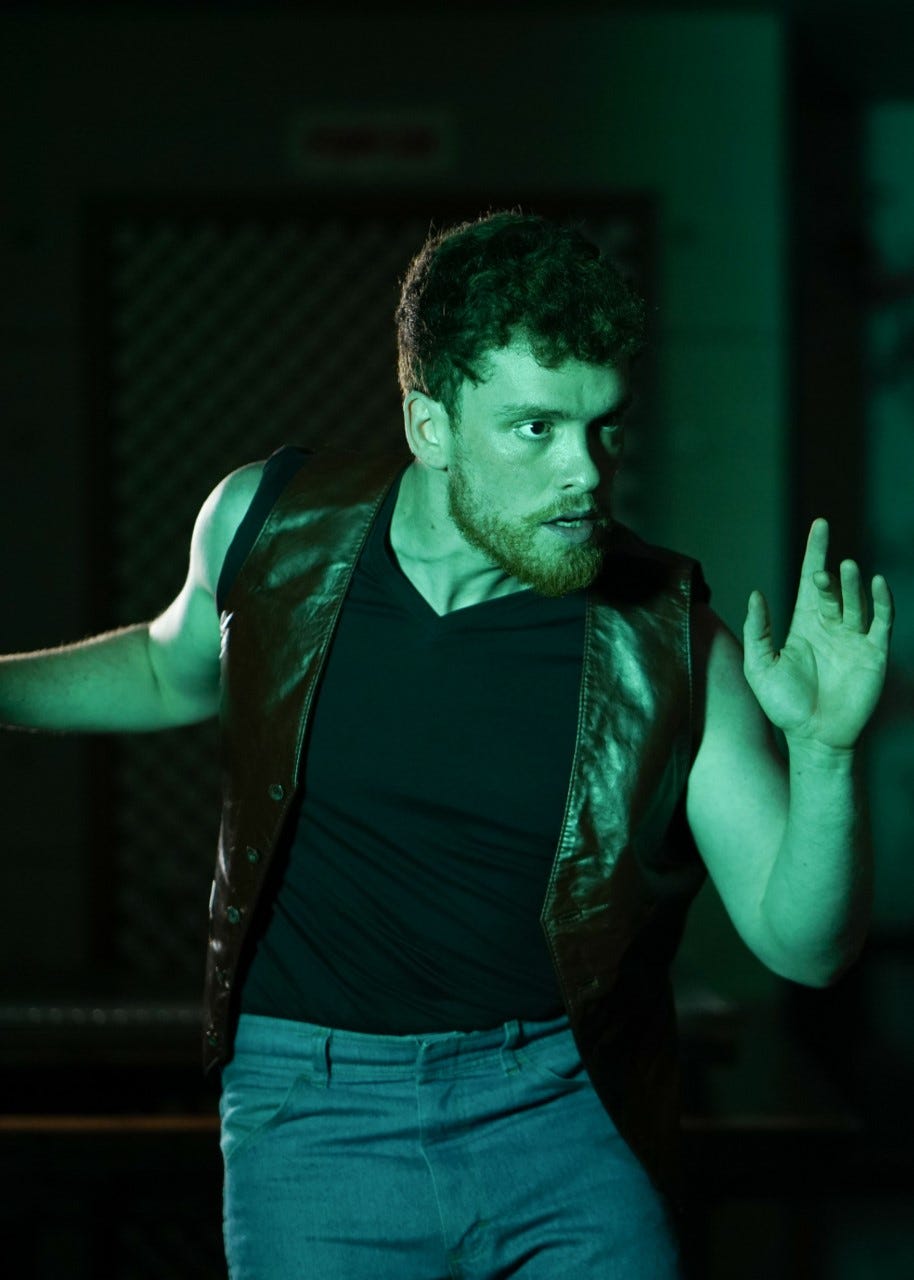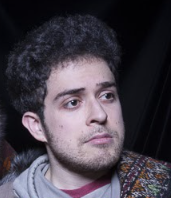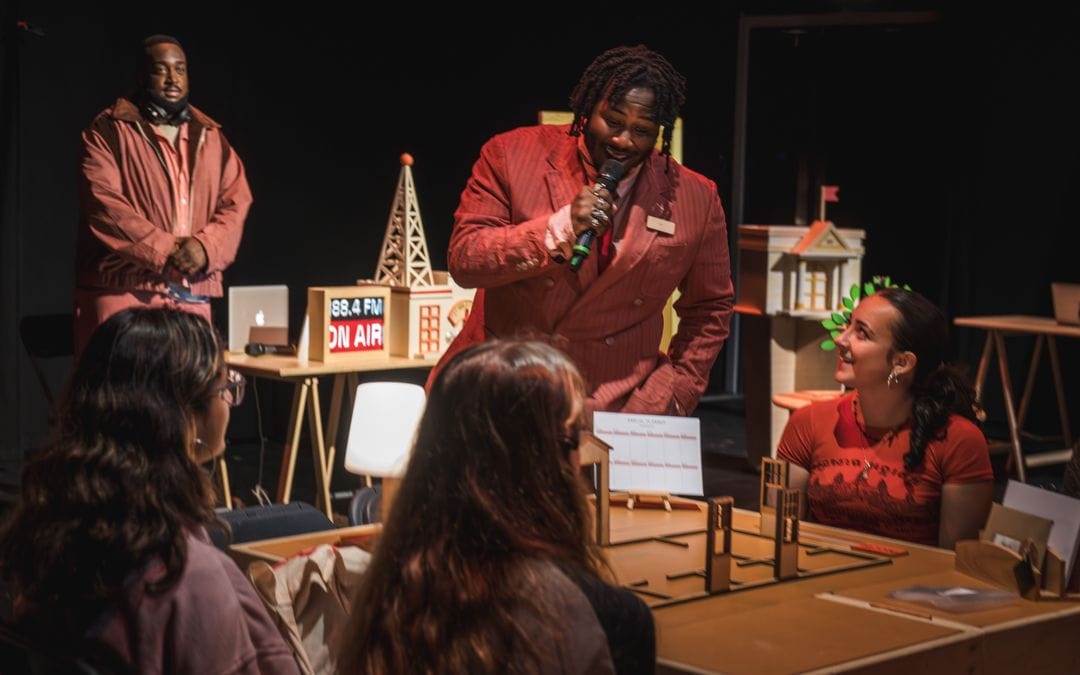
“Blake, this is a karaoke bar.”
It’s raining gently. We’re two blocks from Times Square, and my friend Francis is clearly unimpressed. This is the first immersive production I’ve ever tried to schlep him to, and I’m begging him to give it a chance.
I’m terrified the show we’re about to see is going to be a disappointment — one that turns him off the scene forever.
“Relax! Even if it’s terrible, I’ll get you a drink,” I promise.
“We’ll get burgers after! I even wore my ugly floral shirt to fit in with the 60’s theme!” I say to try to sweeten the deal.
“If you insist….” he relents.
I breathe in deep, relieved that I’d managed to convince him, but suddenly am praying it was actually a good idea to stay.
Fast forward to heading down the stairs, as we prepare to enter the show. The metal door in front of us slides open, untouched, with a loud bang. Two actors — who look oddly alike — get instantly coded in my eyes as twins. They whisper conspiratorially with their backs turned to us, near the middle of an improbably long hallway, washed in blinding neon.

“Hello,” says the first twin, as they spin to meet us.
“I see you have received your invitation. I am Cordelia Carlyle.”
“And I am Crispin Carlyle,” says the second twin.
“Yes,” they say in unison. “We’re related.”
“Oh. It’s that kind of thing.” says Francis, a smile beginning to creep onto his face.
My fears have changed; I know this is going to be a great night. Now, the situation feels closer to the thrill of a roller coaster as it climbs up a steep hill. “Click, click, click,” I think as we approach a private karaoke room with a lone woman standing entranced submerged in a blue glow in the middle.
Here we go.
Get Blake Weil’s stories in your inbox
Join Medium for free to get updates from this writer.
SubscribeSubscribe
Who Killed Edgar Allan Poe? — The Cooping Theory 1969 is not necessarily the easiest show to convince someone to see as I learned first hand. It’s in the basement of a Times Square karaoke bar, and combines two disparate time periods: the 1840’s and late 1960’s. It is not always the easiest show to watch and follow. In a swirl of lights and shrieks and slamming doors and snippets of Poe’s work, sometimes the plot can get a bit lost. However, The Cooping Theory 1969 is one of the easiest to enjoy works of immersive theatre I’ve had the pleasure of taking in. It works marvelously as a delightful kaleidoscope of horror, kitsch, and classic poetry, a fever dream of batty Gothic proportions with shades of Dario Argento (the iconic director of Italian retro horror).

The evening starts out interactive, as I take an oath to join the Poe Society, drink fabulously tacky themed drinks, and mingle with the cast, grooving to a 60’s soundtrack. As I sip my “Anabelle Lee” (a tasty variation on a gimlet), and sing along to “House of the Rising Sun,” and argue about how Nixon possibly could have gotten elected, the trappings of the time period settle perfectly around me. I quickly learn, through whispered gossip, that this isn’t just a party; it’s a seance! Soon we’ll all be gathering to summon the ghost of Poe, and won’t that just be groovy? What was the least inspiring choice of venue turns out to be spectacular; each room is full to bursting with 60’s nostalgia items and deeply unsettling neon lighting, infusing the whole evening with the feel of both Mad Men and horror classic Suspiria.
Eventually, though, the party comes to a stop, as the guest of honor, a famed medium, arrives to summon the ghost of Poe. As you’ve probably guessed, I’ve seen enough horror movies to predict that everything will soon go horribly wrong. And it does, as members of the cast each get possessed one after another, dashing from room to room, twitching and reciting Poe, and occasionally sealing us in for brief intimate scenes. The designers of the Cooping Theory experience have also thoughtfully included a second “cycle” of these same scenes, allowing us to get perspectives on multiple characters without requiring repeat visits.
The characters you’ll find here are all are classic tropes, from Anna the ditzy ingenue (Makaela Shealy), to Jimmy the stoned artist (Johnny Pozzi), and Gina the haunted waif (Samantha Lacey Johnson) who seems a little bit too comfortable with the other side. However, the medium Madam Harlow (Dara Kramer) takes the cake, a psychic icon drenched from head to toe in black lace, a monument of Victorian spiritualist artifice. Although the characters are perhaps a little thinly written on their own, all the actors do a game job of fleshing them out in improv, and together, they form a fun tapestry of genre archetypes and period flavor.
The show manages to have a ton of fun connecting the characters’ 1969-era personal dramas to Poe’s life. Yes, Anna is an actress/model/singer looking to be the next big thing, which is why when Poe possesses her, through her we get memories of Poe’s early years as a writer, gnawed by his hunger for fame and success. Each scene takes on a double meaning, and the ability to follow different actors lets you hone in on getting the secret backstories of each character, and what drew them into the absurd, macabre drama of the Poe Society in the first place. You grow to genuinely care about both these characters, and develop sympathy through them for the unseen Poe, despite the Grand Guignol trappings.

As the show progresses, I notice the sound of a heartbeat is growing louder and louder — and closer now that I think on it. (The show’s sound system is incredible: noises can either come at you from everywhere at once, or stalk you like a jungle cat.) Anna shrieks and points to the door. Jimmy rips it open, panting heavily, hair disheveled.
“It is impossible to say how first the idea entered my brain; but once conceived, it haunted me day and night…”
Anna screams, begging Jimmy to stop, but Jimmy just creeps closer, growing louder and more manic. Gina realizes he’s reciting the opening lines to The Tell-Tale Heart, as if the pounding sound of a heartbeat wasn’t a big enough clue. Now, Tom realizes that what we see in front of us is not Jimmy, but the ghost of Poe in Jimmy’s body; upon this revelation, Tom is now begging him to tell us the secrets of Poe’s death. Now I’ve realized that, despite myself, despite how cliched this scenario sounds, I’m clutching my friend Francis’ shoulder, unsure whether to retreat to the corner or get behind Tom and enjoy the fireworks about to unfold.
If The Cooping Theory has one major flaw, it’s that the production doesn’t necessarily adhere to the kind of logic a show like this typically does. We’re introduced to the titular “Cooping Theory,” a conspiracy theory that Poe was killed in unscrupulous 1800’s electoral practices, but never get closure around his death. Who killed Edgar Allan Poe? We never really find out. Scenes flow too freely for that, amorphously spilling from one to another as the ghost of Poe wreaks havoc upon the Poe Society’s party. The characters of Crispin and Cordelia basically disappear and become ushers and guides after the seance starts. I was left wondering whether this had any significance, or if the show just needed an extra pair of hands and thought it smarter to give them characters to play. Characters seemingly die, then pop right back up, reciting snippets of The Cask of Amontillado. Once the seance begins, we’re fully in the world of dreams. These ambiguities may be frustrating to some. On the other hand, who cares? It’s delightful! There’s blood, and mayhem, and cocktails!

Many horror movies of that era make no sense if I stop to think for a moment. My personal favorite, Phantom of the Paradise, is a collage of Faust, Phantom of the Opera, and The Picture of Dorian Gray as a comic rock opera, and falls apart under even the tiniest bit of scrutiny. I watch it more for the mood: the off-kilter angles, the floods of random pinks and electric blues found in even the most mundane of shots, and the tonally inconsistent bursts of song. And even if the film doesn’t make sense, it’s sincere. I care about the characters because there’s no layer of mockery or irony. It’s entirely genuine in its silliness.
Using the aesthetic of a time period known for its bananas, off-the-wall tonal weirdness paves over any issues I might normally have with a collage like this, mainly by preserving a clarity of intent. The neon lights, giant drinks, and Jefferson Airplane on the playlist call the shot that “I’m here mostly for mood and atmosphere,” and then the actors sink it so perfectly, making me care about the generic, stereotypical college students who so often end up as disposable victims in a horror piece.
Is The Cooping Theory necessarily “capital A” art, rich with meaning and symbolism? I’d rather consider a more appropriate metric: is it comparable to the classic horror films, like Suspiria, that it borrows so much from? In the end, Cooping Theory 1969 is a delightful Halloween Midnight Movie of a show. The myriad of possible meanings, wrapped up in such a tightly crafted aesthetic, elevate the show from mere homage to something spectacular in my book.
In the words of Jimmy and Anna, sipping our drinks after a singalong:
Groovy! Far out, man! That was a blast!
Who Killed Edgar Allan Poe? — The Cooping Theory 1969 continues in Midtown Manhattan on select dates through November 2. Tickets are $75 plus $25 food/beverage minimum; use code POENP for $30 off (not valid Halloween week).
NoPro is a labor of love made possible by our generous Patreon backers. Join them today!
In addition to the No Proscenium web site, our podcast, and our newsletters, you can find NoPro on Twitter, Facebook, YouTube, Instagram, in the Facebook community Everything Immersive, and on our Slack forum.
Office facilities provided by Thymele Arts, in Los Angeles, CA.





















Discussion